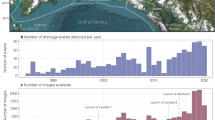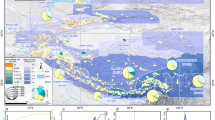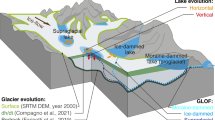Abstract
Shrinking glaciers in the Hindu Kush–Karakoram–Himalaya–Nyainqentanglha (HKKHN) region have formed several thousand moraine-dammed glacial lakes1,2,3, some of these having grown rapidly in past decades3,4. This growth may promote more frequent and potentially destructive glacial lake outburst floods (GLOFs)5,6,7. Testing this hypothesis, however, is confounded by incomplete databases of the few reliable, though selective, case studies. Here we present a consistent Himalayan GLOF inventory derived automatically from all available Landsat imagery since the late 1980s. We more than double the known GLOF count and identify the southern Himalayas as a hotspot region, compared to the more rarely affected Hindu Kush–Karakoram ranges. Nevertheless, the average annual frequency of 1.3 GLOFs has no credible posterior trend despite reported increases in glacial lake areas in most of the HKKHN3,8, so that GLOF activity per unit lake area has decreased since the late 1980s. We conclude that learning more about the frequency and magnitude of outburst triggers, rather than focusing solely on rapidly growing glacial lakes, might improve the appraisal of GLOF hazards.
This is a preview of subscription content, access via your institution
Access options
Access Nature and 54 other Nature Portfolio journals
Get Nature+, our best-value online-access subscription
$29.99 / 30 days
cancel any time
Subscribe to this journal
Receive 12 print issues and online access
$209.00 per year
only $17.42 per issue
Buy this article
- Purchase on Springer Link
- Instant access to full article PDF
Prices may be subject to local taxes which are calculated during checkout




Similar content being viewed by others
Data and code availability
All data on historical and newly detected GLOFs are provided in the Supplementary Information. Additional datasets and codes used for Landsat image processing and time series analysis are available from the corresponding author on request.
References
Ives, J. D., Shrestha, R. B. & Mool, P. K. Formation of Glacial Lakes in the Hindu Kush-Himalayas and GLOF Risk Assessment. (ICIMOD: 2010).
Schwanghart, W., Worni, R., Huggel, C., Stoffel, M. & Korup, O. Uncertainty in the Himalayan energy–water nexus: estimating regional exposure to glacial lake outburst floods. Environ. Res. Lett. 11, 74005 (2016).
Nie, Y. et al. A regional-scale assessment of Himalayan glacial lake changes using satellite observations from 1990 to 2015. Remote Sens. Environ. 189, 1–13 (2017).
Wang, W., Xiang, Y., Gao, Y., Lu, A. & Yao, T. Rapid expansion of glacial lakes caused by climate and glacier retreat in the Central Himalayas. Hydrol. Process. 29, 859–874 (2015).
Harrison, S. et al. Climate change and the global pattern of moraine-dammed glacial lake outburst floods. The Cryosphere 12, 1195–1209 (2018).
Richardson, S. D. & Reynolds, J. M. An overview of glacial hazards in the Himalayas. Quat. Int. 65, 31–47 (2000).
Huss, M. et al. Toward mountains without permanent snow and ice. Earths Future 5, 418–435 (2017).
Gardelle, J., Arnaud, Y. & Berthier, E. Contrasted evolution of glacial lakes along the Hindu Kush Himalaya mountain range between 1990 and 2009. Glob. Planet. Change 75, 47–55 (2011).
Huss, M. & Hock, R. Global-scale hydrological response to future glacier mass loss. Nat. Clim. Change 8, 135–140 (2018).
Lutz, A. F., Immerzeel, W. W., Shrestha, A. B. & Bierkens, M. F. P. Consistent increase in High Asia’s runoff due to increasing glacier melt and precipitation. Nat. Clim. Change 4, 587–592 (2014).
Osti, R. & Egashira, S. Hydrodynamic characteristics of the Tam Pokhari glacial lake outburst flood in the Mt. Everest region, Nepal. Hydrol. Process. 23, 2943–2955 (2009).
Zhang, G., Yao, T., Xie, H., Wang, W. & Yang, W. An inventory of glacial lakes in the Third Pole region and their changes in response to global warming. Glob. Planet. Change 131, 148–157 (2015).
Fujita, K. et al. Potential flood volume of Himalayan glacial lakes. Nat. Hazards Earth Syst. Sci. 13, 1827–1839 (2013).
Rounce, D., Watson, C. & McKinney, D. Identification of hazard and risk for glacial lakes in the Nepal Himalaya using satellite imagery from 2000–2015. Remote Sens. 9, 654 (2017).
Allen, S. K. et al. GAPHAZ 2017: Assessment of Glacier and Permafrost Hazards in Mountain Regions (Standing Group on Glacier and Permafrost Hazards in Mountains (GAPHAZ) of the International Association of Cryospheric Sciences (IACS) & the International Permafrost Association (IPA), 2017).
Emmer, A. GLOFs in the WOS: bibliometrics, geographies and global trends of research on glacial lake outburst floods (Web of Science, 1979–2016). Nat. Hazards Earth Syst. Sci. 18, 813–827 (2018).
Carrivick, J. L. & Tweed, F. S. A global assessment of the societal impacts of glacier outburst floods. Glob. Planet. Change 144, 1–16 (2016).
Nie, Y. et al. An inventory of historical glacial lake outburst floods in the Himalayas based on remote sensing observations and geomorphological analysis. Geomorphology 308, 91–106 (2018).
Veh, G., Korup, O., Roessner, S. & Walz, A. Detecting Himalayan glacial lake outburst floods from Landsat time series. Remote Sens. Environ. 207, 84–97 (2018).
Pekel, J.-F., Cottam, A., Gorelick, N. & Belward, A. S. High-resolution mapping of global surface water and its long-term changes. Nature 540, 418–422 (2016).
Arendt, A. et al. Randolph Glacier Inventory–A Dataset of Global Glacier Outlines: Version 5.0 (Global Land Ice Measurements from Space, 2015).
Brun, F., Berthier, E., Wagnon, P., Kääb, A. & Treichler, D. A spatially resolved estimate of High Mountain Asia glacier mass balances from 2000 to 2016. Nat. Geosci. 10, 668–673 (2017).
Kaser, G., Großhauser, M. & Marzeion, B. Contribution potential of glaciers to water availability in different climate regimes. Proc. Natl Acad. Sci. USA 107, 20223–20227 (2010).
Gardelle, J., Berthier, E. & Arnaud, Y. Slight mass gain of Karakoram glaciers in the early twenty-first century. Nat. Geosci. 5, 322–325 (2012).
Quincey, D. J. et al. Karakoram glacier surge dynamics. Geophys. Res. Lett. 38, 1–6 (2011).
Round, V., Leinss, S., Huss, M., Haemmig, C. & Hajnsek, I. Surge dynamics and lake outbursts of Kyagar Glacier, Karakoram. The Cryosphere 11, 723–739 (2017).
Hewitt, K. & Liu, J. Ice-dammed lakes and outburst floods, karakoram himalaya: historical perspectives on emerging threats. Phys. Geogr. 31, 528–551 (2010).
Song, C. et al. Heterogeneous glacial lake changes and links of lake expansions to the rapid thinning of adjacent glacier termini in the Himalayas. Geomorphology 280, 30–38 (2017).
Wilson, R. et al. Glacial lakes of the central and patagonian andes. Glob. Planet. Change 162, 275–291 (2018).
Worni, R. et al. Analysis and dynamic modeling of a moraine failure and glacier lake outburst flood at Ventisquero Negro, Patagonian Andes (Argentina). J. Hydrol. 444–445, 134–145 (2012).
Nagai, H. et al. Evaluating the scale and potential of GLOF in the bhutan himalayas using a satellite-based integral glacier–glacial lake inventory. Geosciences 7, 77 (2017).
Kraaijenbrink, P. D. A., Bierkens, M. F. P., Lutz, A. F. & Immerzeel, W. W. Impact of a global temperature rise of 1.5 degrees Celsius on Asia’s glaciers. Nature 549, 257–260 (2017).
Linsbauer, A. et al. Modelling glacier-bed overdeepenings and possible future lakes for the glaciers in the Himalaya—Karakoram region. Ann. Glaciol. 57, 119–130 (2016).
Gruber, S. et al. Review article: Inferring permafrost and permafrost thaw in the mountains of the Hindu Kush Himalaya region. The Cryosphere 11, 81–99 (2017).
Haeberli, W., Schaub, Y. & Huggel, C. Increasing risks related to landslides from degrading permafrost into new lakes in de-glaciating mountain ranges. Geomorphology 293, 405–417 (2017).
Ballesteros-Cánovas, J. A., Trappmann, D., Madrigal-González, J., Eckert, N. & Stoffel, M. Climate warming enhances snow avalanche risk in the Western Himalayas. Proc. Natl Acad Sci. USA 115, 3410–3415 (2018).
Kargel, J. S. et al. Geomorphic and geologic controls of geohazards induced by Nepal’s 2015 Gorkha earthquake. Science 351, aac8353-1-10 (2016).
Buckel, J., Otto, J. C., Prasicek, G. & Keuschnig, M. Glacial lakes in Austria – distribution and formation since the Little Ice Age. Glob. Planet. Change 164, 39–51 (2018).
Emmer, A., Klimeš, J., Mergili, M., Vilímek, V. & Cochachin, A. 882 lakes of the Cordillera Blanca: an inventory, classification, evolution and assessment of susceptibility to outburst floods. CATENA 147, 269–279 (2016).
Komori, J., Koike, T., Yamanokuchi, T. & Tshering, P. Glacial lake outburst events in the Bhutan Himalayas. Glob. Env. Res 16, 59–70 (2012).
Wang, W., Yao, T. & Yang, X. Variations of glacial lakes and glaciers in the Boshula mountain range, southeast Tibet, from the 1970s to 2009. Ann. Glaciol. 52, 9–17 (2011).
Bajracharya, S. R., Maharjan, S. B. & Shrestha, F. Clean Ice and Debris Covered Glaciers of HKH Region (Regional Database Initiative, ICIMOD, 2011).
Wulder, M. A., Masek, J. G., Cohen, W. B., Loveland, T. R. & Woodcock, C. E. Opening the archive: how free data has enabled the science and monitoring promise of Landsat. Remote Sens. Environ. 122, 2–10 (2012).
Markham, B. L., Storey, J. C., Williams, D. L. & Irons, J. R. Landsat sensor performance: history and current status. IEEE Trans. Geosci. Remote Sens. 42, 2691–2694 (2004).
Wulder, M. A. et al. The global Landsat archive: status, consolidation, and direction. Remote Sens. Environ. 185, 271–283 (2016).
Landsat Collections (United States Geological Survey, accessed 13 October 2017); https://landsat.usgs.gov/landsat-collections
Geomatics Guidance Note 7, Part 2: Coordinate Conversions & Transformations including Formulas (International Association of Oil & Gas Producers, 2016).
Liu, J., Tang, C. & Cheng, Z. The two main mechanisms of glacier lake outburst flood in Tibet, China. J. Mt. Sci. 10, 239–248 (2013).
Cook, S. J. & Quincey, D. J. Estimating the volume of alpine glacial lakes. Earth Surf. Dyn. 3, 559–575 (2015).
Acknowledgements
This research was funded by Deutsche Forschungsgemeinschaft within the graduate research training group NatRiskChange (GRK 2043/1) at the University of Potsdam (http://www.natriskchange.de). We used the freely available glacier outlines from the Randolph Glacier Inventory (https://www.glims.org/RGI/). Landsat, Shuttle Radar Topography Mission and GTOPO30 data are available from the US Geological Survey (https://www.earthexplorer.usgs.gov). Landsat images were preprocessed via the Earth Resources Observation and Science Center Science Processing Architecture ESPA (https://www.espa.cr.usgs.gov). We used the LandScan (2014) High Resolution global Population Data Set copyrighted by UT-Battelle, LLC, operator of Oak Ridge National Laboratory under Contract No. DE-AC05-00OR22725 with the United States Department of Energy. Our spatial and statistical analysis was entirely based on the statistical software R (http://www.r-project.org/).
Author information
Authors and Affiliations
Contributions
G.V., O.K., S.R. and A.W. designed the study. G.V. performed the Landsat processing with input from S.S., and conducted the statistical analyses with O.K. All authors interpreted and discussed the results. G.V. and O.K. wrote the paper with input by all co-authors.
Corresponding author
Ethics declarations
Competing interests
The authors declare no competing interests.
Additional information
Journal peer review information: Nature Climate Change thanks Adam Emmer, Yong Nie and Weicai Wang for their contribution to the peer review of this work.
Publisher’s note: Springer Nature remains neutral with regard to jurisdictional claims in published maps and institutional affiliations.
Supplementary information
Supplementary Information
Supplementary Figures 1–3, Supplementary Tables 1–2, Supplementary References
Rights and permissions
About this article
Cite this article
Veh, G., Korup, O., von Specht, S. et al. Unchanged frequency of moraine-dammed glacial lake outburst floods in the Himalaya. Nat. Clim. Chang. 9, 379–383 (2019). https://doi.org/10.1038/s41558-019-0437-5
Received:
Accepted:
Published:
Issue Date:
DOI: https://doi.org/10.1038/s41558-019-0437-5
This article is cited by
-
Review of glacier velocity and facies characterization techniques using multi-sensor approach
Environment, Development and Sustainability (2024)
-
Enhanced glacial lake activity threatens numerous communities and infrastructure in the Third Pole
Nature Communications (2023)
-
Glacial lake outburst floods threaten millions globally
Nature Communications (2023)
-
Source processes associated with the 2021 glacier collapse in the Yarlung Tsangpo Grand Canyon, southeastern Tibetan Plateau
Landslides (2023)
-
Spatiotemporal analysis of Imja Lake to estimate the downstream flood hazard using the SHIVEK approach
Acta Geophysica (2023)



